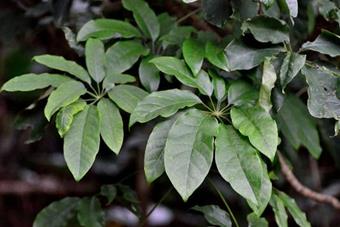江某 Common Schefflera (Jiangmou)

冬天開花結果的江某,花朵並不具有香氣,但花含蜜量豐富,經常吸引許多蝴蝶、食蚜蠅、麗蠅等昆蟲聚集,是冬季很重要的蜜源植物,而果實也可彌補野鳥冬天食物的不足。
The Common Schefflera (pronounced Jiangmou in Mandarin) is also known as "Duck Foot Wood" (Yajiaomu) or "Goose Foot Wood" (Ezhangchai), because its leaves are palmately compound leaves with a shape like duck feet or goose feet. The core of the trees is white in color and substantial in texture, and therefore traditionally used to make matches and clogs. A question often posed is: why call it "Jiangmou?" This is because when Taiwan was under Japanese rule wearing clogs was a fashion, and since there's no distinction between left-foot and right-foot clogs, people couldn't tell which was which. As a result, Jiangmou became the trees having no distinction between "Gangmou". The term "Jiangmou" (Mandarin) is the assonance of the term "Gangmou" (Minnan dialect).
The Common Schefflera blossoms and bears fruit in winter. Although the flowers do not have a sweet smell, the rich nectar still attracts many insects, including butterflies, flower flies, blow flies, etc. They are very important nectar plants in winter, and their fruit also provides wild birds with extra food in winter.
